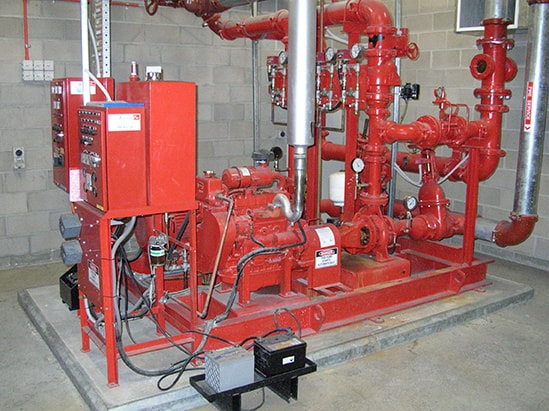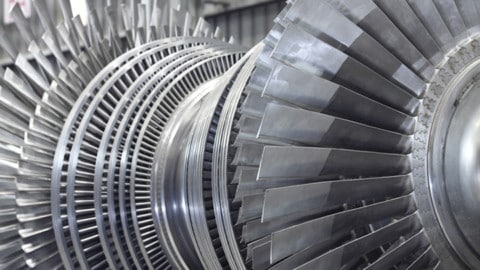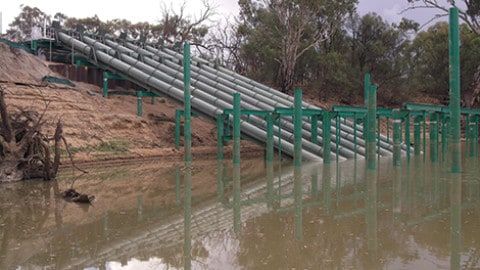By Matthew Wright – Chief Technical Officer / Deputy CEO, FPA Australia
Matthew Wright from FPA Australia takes a look at the requirements for fire pumpsets in new buildings in accordance with the Building Code of Australia and maintenance of existing fire pumpset installations.
 Fire pumpsets are critical infrastructure installations in many buildings and facilities throughout the world. The efficiency of water as a fire suppression agent is well recognised however water’s suppression qualities are often measured by the quantity and speed by which it can be applied to a fire.
Fire pumpsets are critical infrastructure installations in many buildings and facilities throughout the world. The efficiency of water as a fire suppression agent is well recognised however water’s suppression qualities are often measured by the quantity and speed by which it can be applied to a fire.
The evolution of water based suppression systems includes such low tech endeavours of the “bucket brigades” of the 1800’s, installation of reticulated water supply and steam powered – horse drawn pumps right through to the comparatively advanced fire hydrant and sprinkler systems of the 21st century. Most conventional and contemporary water based fire suppression systems rely on the fire pumpset to deliver water on demand at an expected pressure and flow rate in order to achieve system performance.
New buildings
The Building Code of Australia, now part of the National Construction Code Series alongside the Plumbing Code of Australia contains performance requirements that require installation of suppression systems appropriate to fire hazard. The deemed-to-satisfy (DtS) provisions of the BCA may be used to meet these performance requirements and prescribe requirements for the installation of fire hydrant, fire hose reel, and sprinkler systems in buildings. Although alternative solutions may be legitimately developed to satisfy the performance requirements, this approach is dependent on building specific knowledge. Accordingly this article focusses on the prescribed requirements.
The DtS requirements reference Australian Standards to describe the minimum technical installation requirements regarding these systems. Where fire pumpsets are determined to be necessary to ensure water pressure and flow performance, these standards reference compliance with AS 2941 -2008.
The below table provides a basic outline of the DtS clauses and standards referenced by the BCA that lead to requirements to comply with AS 2941 – 2008 – Fixed fire protection installations – Pumpset systems.
|
System |
Relevant BCA DtS clause |
Primary installation standard referenced by BCA |
Secondary installation standard |
|
Fire Hydrants |
E1.3 |
AS 2419.1 – 2005 |
AS 2941 – 2008 |
|
Fire Hose Reels |
E1.4 |
AS 2441 – 2005 |
|
|
Sprinklers |
E1.5 |
AS 2118.1 – 1999 AS 2118.4 – 1995 AS 2118.6 – 1995 |
FPA Australia members are representatives of FP-009, the Standards Australia committee responsible for the development of AS 2941 – 2008. This standard is currently under review with the following aspects being considered:
• alignment between AS 2941 and AS/NZS 3000 (Electrical) – clarifying all the electrical requirements. The most significant change being the need for a Circuit Breaker in the Electric Fire Pump Controller,
• providing a consistent fire pump design duty point for all applications – hydrants, sprinklers, combined hydrant and sprinklers, residential,
• clarifying and tightening of requirements for battery charges and batteries to address the spate of battery explosions that has been reported,
• tightening up wording and figures to ensure there are no inconsistencies and loopholes on a variety of issues – diesel driver heat exchanger cooling system, circulation relief valve sizing,
pressure relief valve applications and design, control systems for jockey and jacking pumps, etc.,
• all figures will be revised as needed,
• diesel Engine Power ratings clarified,
• significant change in requiring one ECM for Diesel engines instead of two.
Regardless of these revisions aimed at improving the pumpset standard, it is important to recognise that the current version referenced by the suppression standards included in the BCA remains the minimum installation requirement. FPA Australia will provide further updates to the industry pending the publication of any revision(s) to the Standard and what this may mean for compliance.
In addition to prescribing installation requirements, the BCA also includes requirements to demonstrate evidence of suitability – that is – documentation that demonstrates products will achieve a level of performance necessary to comply. Clause A2.2 of the BCA provides options regarding the type of documentation that may be presented as evidence of suitability. It should be noted that although there is essentially five different options, there is no hierarchy to the application of these and they are not equal in terms of rigour or application. The number of options assist in meeting Australia’s commitment to the World Trade Organisation Agreement to reduce Technical Barriers to Trade and stimulate trade between member countries but retain minimum local requirements.
These evidence of suitability requirements have existed without much variation since the BCA was first published in 1990. However, FPA Australia is anecdotally aware that these evidence of suitability requirements are being applied to various degrees across the fire protection industry and is preparing to release comprehensive guidance on this matter to increase understanding and awareness of what is required. In the meantime fire pumpset manufacturers, suppliers, installers and certifiers would be well informed to ensure the evidence of suitability they provide, request or receive complies with the BCA options and does in fact confirm that the product in question complies.
Maintenance
Meeting the minimum installation requirements is insignificant if the pumpset is not maintained in order to perform as expected, when necessary. Maintenance of fire protection systems and equipment is regulated in each state and territory of Australia however an “ignorance is bliss” style complacency is still held by some property owners regarding the importance of maintenance. This seems to especially apply if the equipment is located in a dark room in the belly of their building – out of sight, out of mind.
Common issues reported to FPA Australia include simple and obvious issues such as;
• no fuel or power supply;
• battery failed; and
• pump not running
right through to:
• inappropriate pressure limit settings;
• pump remaining isolated after repairs
have been completed; and
• not running the pump in test mode.
Fire pumpsets can often be one of the most neglected pieces of fire protection infrastructure despite being the “heart” of the systems they support. Consider the concessions provided to a building design on the basis of a sprinkler system installation. These can include, reduction of fire ratings, deletion of spandrels and even increasing of travel distances when alternative solutions are developed. Such concessions are of course predicated on the fact that the sprinkler system will perform. Where sprinkler systems include a fire pumpset, operation of the pumpset is fundamental to achieving such performance.
The Australian Standard for maintenance of fire protection systems and equipment is AS 1851 – 2005. This standard is referenced by regulation to varying degrees around Australia and is about to be superseded by a new version which has been the result of extensive development, public comment and review.
FPA Australia is preparing to offer a comprehensive national seminar series in relation to the new standard. The approach being considered is to provide information on the general parts of the standard that apply to all systems and equipment and then include individual streams dedicated to specific equipment. This will allow for focussed discussion.
Fire pumpsets are critical infrastructure and meeting the minimum requirements for installation and maintenance is important to achieving expected performance.



















Comments are closed.